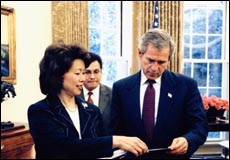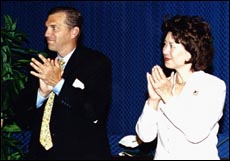LABOR
Making the President's Management Agenda Work at Labor
 Here at the Department of Labor, we recognized early on that we could not reform the organization without the active involvement of all of our senior career and noncareer officials. To that end, in August 2001 Secretary Chao created the "Management Review Board" to consider Department-wide crosscutting management issues. At our MRB meetings, our senior executives vet management ideas, share best practices, and provide progress updates. Representatives from the Office of Management and Budget often attend MRB meetings to provide input. I also meet formally at least once a month with each of our agency heads to assess each agency's progress on the five initiatives of the President's Management Agenda. And, most recently, we convened all of the Department's Senior Executive Service officials from around the country for a day-long session to reinforce our focus on improving the management of the Department.
Here at the Department of Labor, we recognized early on that we could not reform the organization without the active involvement of all of our senior career and noncareer officials. To that end, in August 2001 Secretary Chao created the "Management Review Board" to consider Department-wide crosscutting management issues. At our MRB meetings, our senior executives vet management ideas, share best practices, and provide progress updates. Representatives from the Office of Management and Budget often attend MRB meetings to provide input. I also meet formally at least once a month with each of our agency heads to assess each agency's progress on the five initiatives of the President's Management Agenda. And, most recently, we convened all of the Department's Senior Executive Service officials from around the country for a day-long session to reinforce our focus on improving the management of the Department.
Progress in Human Capital
Like many federal departments, Labor faces major challenges in the area of human capital management. One issue is that increasing numbers of our senior executives are now, or will soon be, eligible to retire. Indeed, more than 50 percent of Labor's senior executives are eligible to retire within the next five years.
 To ensure capable executive leadership for the future, we have implemented a highly successful MBA Outreach Program to recruit MBA graduates to join Labor. Under this program, we are aggressively recruiting both recent MBA graduates interested in public service and mid-level and management-level MBAs seeking a career change. Candidates may be eligible for hiring incentives, such as recruitment bonuses and student loan repayment, and will participate in a leadership program that provides rotational assignments throughout DOL, training, and advancement opportunities. In addition, we established a Senior Executive Service Candidate Development Program, in which Secretary Chao selected a group of high-potential executive candidates from Labor, other government agencies, and the private sector to participate in a rigorous SES training program.
To ensure capable executive leadership for the future, we have implemented a highly successful MBA Outreach Program to recruit MBA graduates to join Labor. Under this program, we are aggressively recruiting both recent MBA graduates interested in public service and mid-level and management-level MBAs seeking a career change. Candidates may be eligible for hiring incentives, such as recruitment bonuses and student loan repayment, and will participate in a leadership program that provides rotational assignments throughout DOL, training, and advancement opportunities. In addition, we established a Senior Executive Service Candidate Development Program, in which Secretary Chao selected a group of high-potential executive candidates from Labor, other government agencies, and the private sector to participate in a rigorous SES training program.
A second issue is one common to many other government agencies - a rigid and inefficient personnel system. Not only has the Department of Labor participated in government-wide legislative and other efforts to provide managers more flexibility, but the Department has also completely overhauled its performance evaluation system for top managers. In the past, the Department's various agencies used a hodge podge of different rating elements, rating levels, and so forth, making it virtually impossible to compare managers from different agencies. Now, the performance appraisal system incorporates several standard performance elements and the same rating levels. Moreover, the new system specifically requires managers to be evaluated on their progress in implementing the President's Management Agenda and other departmental goals.
Leading the Way in E-Government
Since early this year, I have chaired the President's Management Council's Committee on E-Government. We are trying to rationalize the government's many information technology activities and implement the 24 presidential priority E-Government initiatives. One of those initiatives is www.GovBenefits.gov. This website allows a user to answer a short series of plain-English, yes-no questions, then returns a list of federal benefit programs for which he or she may be eligible. To get this project done quickly - GovBenefits was the first of the E-Gov initiatives to launch publicly -
 we dedicated a project manager to oversee the development of the website.
We also established a clear business plan setting forth the value of this website, namely bringing together in one place the myriad sources of benefits for American citizens. Communicating this vision was critical to getting the cooperation and investment of the 11 participating agencies. We recently added to the site new programs with budgets totaling $34 billion, helping us achieve our goal of adding 20-40 new programs to the site each month. More recently, we launched www.DisabilityInfo.gov, a new website that collects in one place all of the government's information for people with disabilities. The public's reaction to these initiatives has been overwhelmingly positive, and Labor is proud of how these websites make government more accessible to the American people.
we dedicated a project manager to oversee the development of the website.
We also established a clear business plan setting forth the value of this website, namely bringing together in one place the myriad sources of benefits for American citizens. Communicating this vision was critical to getting the cooperation and investment of the 11 participating agencies. We recently added to the site new programs with budgets totaling $34 billion, helping us achieve our goal of adding 20-40 new programs to the site each month. More recently, we launched www.DisabilityInfo.gov, a new website that collects in one place all of the government's information for people with disabilities. The public's reaction to these initiatives has been overwhelmingly positive, and Labor is proud of how these websites make government more accessible to the American people.
Ensuring That Our Budget Is Based on Solid Analysis
What Labor has done to implement the President’s Management Agenda:
- Created a "Management Review Board" to consider Department-wide, crosscutting management issues.
- Implemented an MBA Outreach Program to recruit MBA graduates and established a Senior Executive Service Candidate Development Program.
- Articulated a clear business plan setting forth the value of one of its e-government initiatives, which was critical to getting the cooperation and investment of 11 participating agencies.
- Moved away from output-oriented goals toward more outcome-oriented goals, like determining actual reductions in workplace discrimination.
|
The premise of the "Budget and Performance Integration" initiative is simple: programs that perform well should be continued and nurtured, while programs that do not perform well should be phased out or fixed. Integrating budget and performance is a challenge for Labor, particularly in the area of performance-to-budget metrics. Specifically, measuring the success of many of our agencies involves proving a negative - showing an absence of the workplace violations that we are charged with eliminating. This can be a difficult proposition, but we are making progress. For example, the Office of Federal Contract Compliance Programs, our agency charged with ending discrimination among federal contractors, has recently moved away from the output-oriented goal of simply measuring the numbers of various evaluations performed toward a more outcome-oriented goal of determining actual reductions in workplace discrimination.
We are also working hard to make budget decisions based on the performance of the programs we are funding. For instance, studies have shown that our Job Corps program is particularly effective in preparing at-risk youth for future employment. Because of this demonstrated performance, the President proposed increasing the Job Corps budget in his Fiscal Year 2003 budget. The Fiscal Year 2004 budget that Labor recently submitted to OMB represents the Department's first effort to integrate in its budget the performance goals that we expect funded programs to achieve.
These are some of the tangible results that the President's Management Agenda is delivering at Labor. I look forward to giving you more insight into our efforts in the future.
Sincerely,
D. Cameron Findlay
Department Updates:



